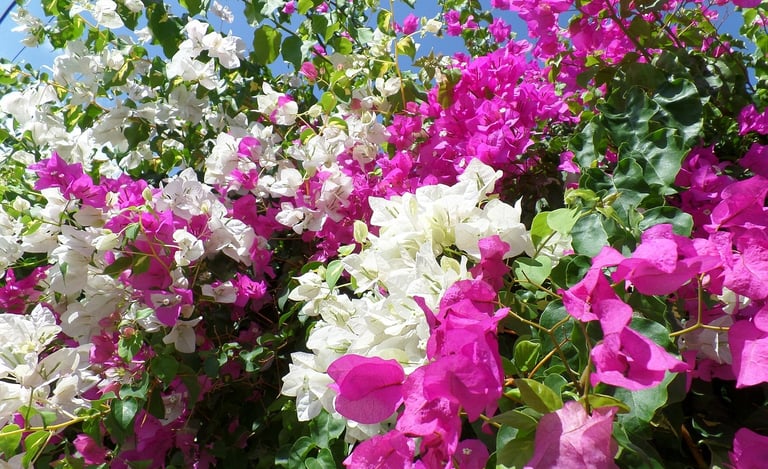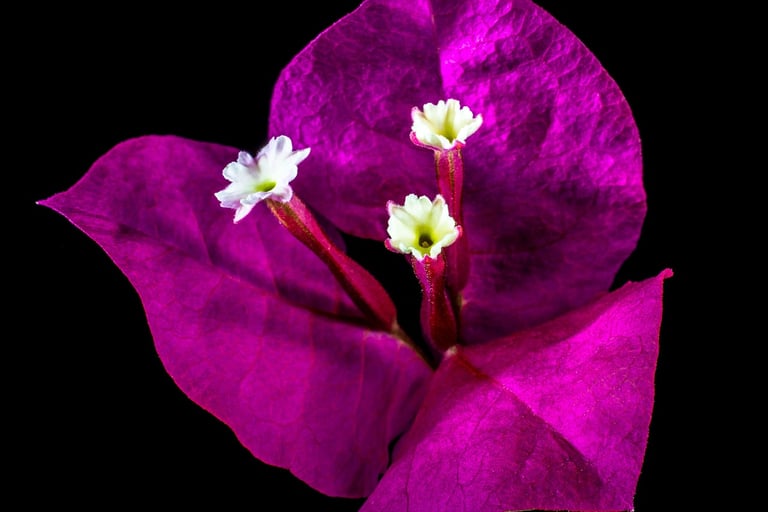Bougainvillea: The Eternal Bloom of Strength and Story
Bougainvillea is more than a flower—it’s a tale of resilience, beauty, and endurance across time and cultures. From folklore to flourishing landscapes, discover the story behind this timeless bloom.
MINDMUSE


Originating in South America, specifically Brazil, Peru, and Argentina, bougainvillea is a colourful and hardy flowering plant. During an expedition headed by Louis Antoine de Bougainville in 1768, French botanist Philibert Commerson made the first written record of it. In honour of the explorer, the plant was named Bougainvillea, making it one of the rare flowers named after a navigator rather than a scientist.
Yet, history carries a hidden thread — it is thought that Commerson's assistant, Jeanne Baret, who was the first woman to travel around the world, contributed to the plant's identification. She started the journey in secret by posing as a man to get around the limitations of the time. If accurate, the plant of tenacity, endurance, and hidden strength, bougainvillea, becomes an unspoken homage to her bravery.
Journey from South America to the World
Bougainvillea was brought to France and England by plant collectors, where it quickly gained popularity in royal gardens and greenhouses. Admired for its vibrant colours and capacity to flourish in warm climates, it had spread throughout Europe by the early 19th century.
It made its way to India in the early 19th century, likely brought by British colonial botanists and horticulturists who introduced it as an ornamental plant. One significant figure credited with spreading Bougainvillea in British India was Sir George King, the first director of the Royal Botanic Garden, Kolkata. The British found it ideal for India’s climate—heat-tolerant, drought-resistant, and fast-growing—and planted it extensively in gardens, along roadsides, and near colonial bungalows.
Bougainvillea is often called the ‘paper flower’ due to the delicate, papery texture of its vibrant, thin bracts, which are often mistaken for petals. These bracts come in shades of magenta, pink, red, orange, white, and yellow, adding an explosion of colour to landscapes. Unlike most flowers, the true Bougainvillea flower is small, tubular, and typically white or pale yellow, nestled within the three colourful bracts that surround it. These bracts are modified leaves, light, thin, and slightly crinkled, resembling handmade paper. The papery bracts serve a crucial role in attracting pollinators like bees, butterflies, and hummingbirds by mimicking the function of petals. Their texture helps them survive in hot and dry climates by reducing moisture loss, making them a symbol of adaptability and endurance. Unlike many flowering plants, Bougainvillea has no significant scent—it relies purely on its brilliant colours for pollination rather than fragrance.
Bougainvillea—beauty in resilience.


A delicate truth hidden within vibrant bracts.


One plant, many colours—Bougainvillea’s natural magic.
Bougainvillea is a plant of survival, adapting to its environment by shifting between evergreen and deciduous forms. In humid, high-rainfall regions, it remains lush and evergreen, while in drought-prone areas, it sheds its leaves to preserve moisture. To thrive, Bougainvillea requires at least six hours of direct sunlight daily, as abundant sunlight encourages profuse blooming. It flourishes in temperatures ranging from 15°C to 40°C but is susceptible to frost. The plant prefers well-drained, sandy, or loamy soil, as excessive watering can impede flowering and lead to root issues.
Bougainvillea’s drought resistance, rapid growth, and striking ornamental beauty have made it a popular plant worldwide. With its vivid blooms, it is frequently used as a decorative plant in gardens to adorn walls, fences, and archways. In addition to being aesthetically pleasing, its deep roots are essential for stopping soil erosion, particularly in tropical areas. Bougainvillea improves the environment by adding colour and shade to cityscapes and highways. It is also cherished in bonsai art, where its resilience and delicate bracts make it a favourite among enthusiasts. Additionally, Bougainvillea has medicinal significance, with its flowers and leaves traditionally used for treating respiratory ailments, diabetes, and inflammation.
Bougainvillea is a symbol of resilience and strength, thriving in harsh conditions and representing perseverance, endurance, and the ability to rise after difficulties. In many cultures, it is believed to bring protection and positivity. In India, China, and Southeast Asia, Bougainvillea is often planted near homes and temples to ward off negativity and invite good fortune. Its blazing colours—deep pinks, purples, and reds—are linked to love, passion, and romantic devotion, making it a flower of intense emotions. In Feng Shui, Bougainvillea embodies vital Yang energy, and placing it near entrances is believed to draw prosperity, happiness, and success.
Bougainvillea is also a symbol of tropical beauty and resilience, deeply cherished in several regions. Grenada's vibrant energy is reflected in its brilliant blooms, which are officially recognized as the island's national flower. Guam and the Philippines honour bougainvillea as a symbol of elegance and versatility, even though it is not officially recognized. Its vibrant colours and timeless appeal adorn their landscapes.
Beyond its beauty and resilience, Bougainvillea has also found a place in myths and folklore, where its vibrant blooms carry stories of passion, transformation, and destiny.
In an old Brazilian folktale, a young woman named Iara fell in love with a warrior from a rival tribe. One tragic night she was chased into the forest by her own people because their love was forbidden. She prayed to the gods in desperation for help. A thorny vine with glowing flowers bloomed around her in response, creating an impenetrable barrier. Her pursuers could not reach her, and she became one with the plant, forever remembered as the Bougainvillea—a symbol of love’s resilience and the power of protection.
Narcissus, the young man who was cursed to love his own reflection, is shown in a contemporary poetic parallel wandering far into the forest without realizing that his destiny was about to change. He found a wall covered in the fiery blooms of bougainvillea instead of a still pond.
In contrast to the fragile daffodil (Narcissus flower), which bent toward the ground, bougainvillea grew, spread, and thrived—unaffected by time or wind. For the first time, Narcissus saw something much bigger than himself—wild, untamed, and alive. Attracted by its rebellious beauty, he reached out, but the prickly vines resisted. The bougainvillea did not exist to be admired; rather, it flourished as it was strong, unaffected by conceit.
Had he understood its lesson, perhaps he would not have withered in his own reflection but risen beyond it—resilient, fearless, and free, like the flower before him.
Like Narcissus, we frequently look for beauty in things that reflect us, but we fail to see that true strength is found in things that are not dependent on our eyes. A vibrant display of colour that flourishes where others wither, bougainvillea is a living example of nature's subdued power. Its resilience allows it to thrive in the face of adversity, embrace the sun, and weather storms. Its defiant bloom reveals a simple truth: beauty is found in the will to persevere, rise, and bloom again, not just in momentary perfection.
